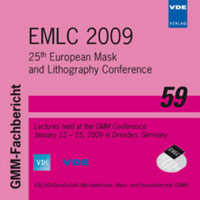New writing strategy in electron beam direct write lithography to improve critical dense lines patterning for sub-45nm nodes
Conference: EMLC 2009 - 25th European Mask and Lithography Conference
01/12/2009 - 01/15/2009 at Dresden, Germany
Proceedings: EMLC 2009
Pages: 12Language: englishTyp: PDF
Personal VDE Members are entitled to a 10% discount on this title
Authors:
Martin, L.; Manakli, S.; Icard, B.; Pradelles, J.; Pain, L. (CEA-LETI, MINATEC, 17 rue des martyrs 38054 GRENOBLE Cedex 9, France)
Orobtchouk, Régis; Poncet, Alain (INL, INSA Lyon, 20 avenue Albert Einstein, 69621 VILLEURBANNE Cedex, Fr)
Abstract:
Electron beam direct write lithography is known for its high resolution capabilities, which enables studies ahead of the technology in production. That is why this technique is used for many years in laboratories for R&D. Recently it was shown that electron beam lithography can be integrated within the flows of the microelectronics industry for prototyping applications, low volume production and to support optical lithography for ASIC manufacturing. Moreover recent lithography workshops highlighted that the multi beam solution is identified as one potential technique for next generation lithography techniques to meet the requirements of sub-32nm technological nodes. The present proximity correction methods for electron beam lithography are based on the standard dose modulation principle. However these methods cannot properly ensure a sufficient control of the patterning of the most critical designs. To push the resolution capability of electron beam lithography, a new correction method is proposed. It consists in a multiple pass exposure strategy. For example instead of patterning a line in one pass (standard exposure), the pattern is split in several basic blocks with potential overlaps exposed in several passes and with an adapted dose. Compared to standard exposure, this solution provides an improved process window and a better control of the critical dimensions. We could achieve energy latitude of 22.2% and we improved the line edge roughness by 27% on 45nm dense lines (line width equal to space) with this method.


